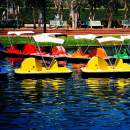Vibrant colors without increasing contrast
This easy Photoshop post-processing technique shows how to transform a dull looking photo coming out of a digital camera and get the vibrant colours it should have. Most cameras, even pro’s models, under achieve the colours giving the maximum possibilities for post-processing. With this simple technique, we’re using Lab colors to increase saturation on all colors but not increasing edges contrast.
It’s best used in landscapes, cityscapes, still life and everything but it should be avoided for portraits, which look better (natural) less saturated.
Before & After


1- Convert to Lab colors (Image > Mode > Lab Color)
We convert to a different color space. You should be in RGB, and going Lab Color.
Lab color gives us much better control over colors since it separates colors from lightness (different channels). In RGB mode, the lightness is included inside the R (red), G (green) and B (blue) channels. Therefor any increase in saturation in RGB results in a higher contrast in lightness… Too much of it and you end up with a terrible picture.
2- Select the “a” channel (in Channels palette, or CTRL+2)
3- Apply Levels mathematically to channel a (Image > Adjustment > Levels… or CTRL+L)
In Lab colors, the colors are mixed within channel A and channel B. We’re leveling both channels blacks and white identically the same (mathematically) in order not to screw the colors. It’s easy to unballanced the colors if you don’t respect this.


As you can see on the two previous panels, the blacks have gone up 55 and the white have been lowered 55. This is basically the amount of saturation you’re going to apply on your colors.
4- Do the same for Channel b
Same amount, 55 in this case. If you don’t respect the same amount than for channel a, you will end up with alien colors.
5- Convert back to RGB
Done!
Finally, I chose to post-process the colors and add a dramatic sky.
Three examples (click for larger image):



More examples of these can be found on my photoblog: Lightfocus.org.
technorati tags:photography, digital, photoshop, vibrance, colour, contrast, manipulation


No comments:
Post a Comment